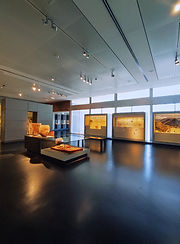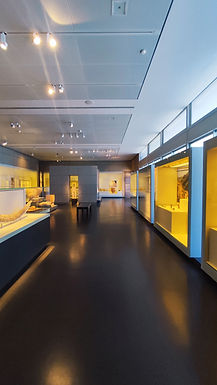Adventure at the Lost Souls Wing- extended case study
client: The Israel Museum, Jerusalem
Project Overview
The "Lost Souls Wing" is an interactive game developed in collaboration with the Archaeology Department of the Israel Museum. This project was created as part of a Master's degree in Digital Game Design and Development at Shenkar College.
The game enhances the visitor experience in the museum's Archaeology Wing by adding a mysterious, challenging, and entertaining narrative layer. Designed for all ages, it can be played individually or in groups.

Roles
UI/UX Designer
UX Researcher
Storyline Development
Tools
Figma, Adobe Suite,
User Interview, Research,
Prototyping
Challenge
The Archaeology Wing houses numerous artifacts that tell the story of human civilization. However, these treasures are often hidden behind layers of text and information, competing for visitors' attention. This wealth of exhibits can sometimes lead to visitors missing unique items or failing to understand their full context and historical significance.

User Surveys
We conducted surveys with visitors to understand their interaction with the museum and its artifacts:
🔥
66% of visitors did not notice the world’s oldest campfire remains on display.
🐘
30% of visitors misidentified key artifacts, such as the prehistoric elephant tusk.
💬
75% of visitors desired a more interactive and narrative-driven experience.



Testimonies
"The world’s oldest campfire? I didn’t realize it was in the exhibition!" – Ohad, Tel Aviv.
"I saw a burial with a woman and an animal but didn’t catch that it was the first domesticated animal in history." – Navit, Modiin.
"It was impressive, but I don’t remember much." – Osnat Shaked, Pardes Hanna.
Insights
After conducting interviews with museum visitors and curators, we identified four key user insights:
-
Visitors want a deeper connection with artifacts.
-
Overwhelming information made some exhibits hard to remember.
-
Curators and museum personals prefer games that enhance rather than interrupt the flow of the museum visit.
-
The ability to replay and build a collection over time encourages repeat visits.
Existing Solutions
- Exlorial – An app-based city tour game that guides users to points of interest through clues.
- Murder at the Met – A phone-based detective game that leads museum visitors through solving a mystery by interacting with artworks.
- "Mobile Serious Game for Enhancing User Experience in Museums" – A research paper recommending minimizing screen use during museum-based games to enhance engagement with exhibits.
Game mechanics insights
Based on this research and interviews, these are the key insights regarding game mechanics:
-
Narrative-based interactions: Implement engaging storylines that are tied to specific artifacts, encouraging visitors to explore the exhibits in a more meaningful way.
-
Treasure hunt mechanics: Incorporate elements of a treasure hunt, such as clues, riddles, or challenges, to motivate visitors to actively seek out and discover hidden information or rewards within the museum.
-
Minimal screen-based experience: Prioritize a hands-on, immersive experience by minimizing reliance on screens. Encourage visitors to focus on the physical exhibits and interact with them directly.

Design Principles and Wireframe
The game is intended to accompany, not replace, the museum visit experience. It aims to highlight key artifacts while encouraging players to focus on the museum’s objects, not their phone screens. By incorporating narrative elements that connect the items to their natural historical context, the game fosters an emotional bond between the players and the artifacts.
In each room, curators can choose three highlighted objects that the players must discover. These discoveries will encourage visitors to engage with the other exhibits in the room, potentially sparking curiosity and prompting further exploration










Gameplay Mechanics
-
Treasure Hunt and Discovery
-
Shape Matching
-
Riddle Solving
-
Collection Building
User Journey
Upon entering the Archaeology Department, players encounter wandering, lost souls. One of the souls approaches and asks for help in finding an object that once belonged to them. Through a series of fragmented memories and clues, the soul guides the player to the artifact. Once discovered, the players are transported back in time through the eyes of the soul, witnessing the object in its original context and gaining a deeper understanding of its historical significance.
The objects collected during gameplay are saved in the player’s private museum collection, which grows with each visit, encouraging repeated play and deepened interaction with the museum’s exhibitions
User Journey
Upon entering the Archaeology Department, players encounter wandering, lost souls. One of the souls approaches and asks for help in finding an object that once belonged to them. Through a series of fragmented memories and clues, the soul guides the player to the artifact. Once discovered, the players are transported back in time through the eyes of the soul, witnessing the object in its original context and gaining a deeper understanding of its historical significance.
The objects collected during gameplay are saved in the player’s private museum collection, which grows with each visit, encouraging repeated play and deepened interaction with the museum’s exhibitions
Prototype
The design is heavily inspired by the real museum environment, particularly the Archaeology Wing, seamlessly blending the physical space with the digital experience. It also draws from popular games and movies that combine historical exploration with supernatural elements, enhancing user engagement while preserving the educational focus of the museum visit. Key inspirations include Ghostbusters, Night at the Museum, and Goosebumps book covers, among others. These influences make the experience both familiar and immersive for visitors.








Detailed Design




